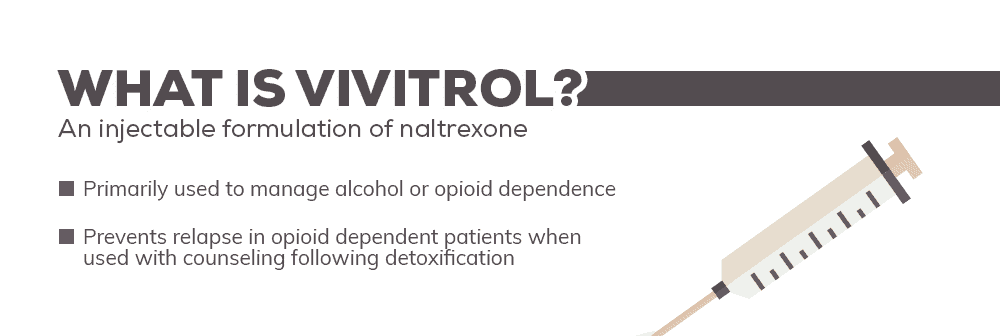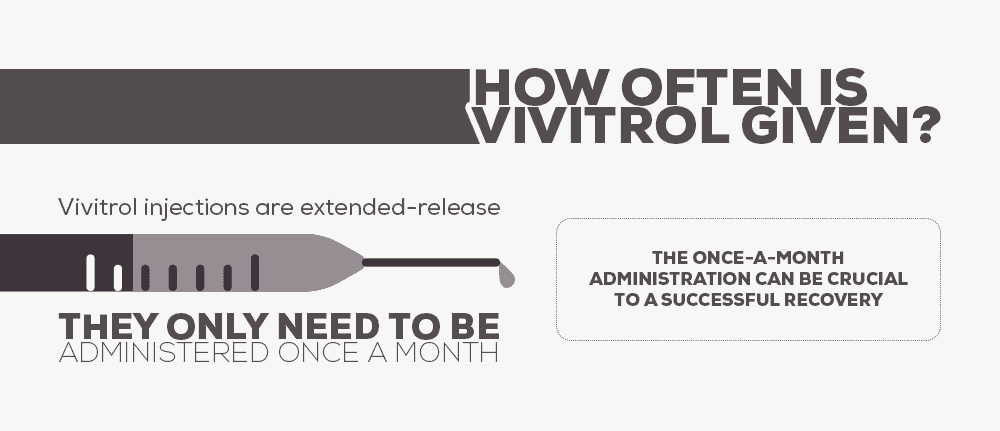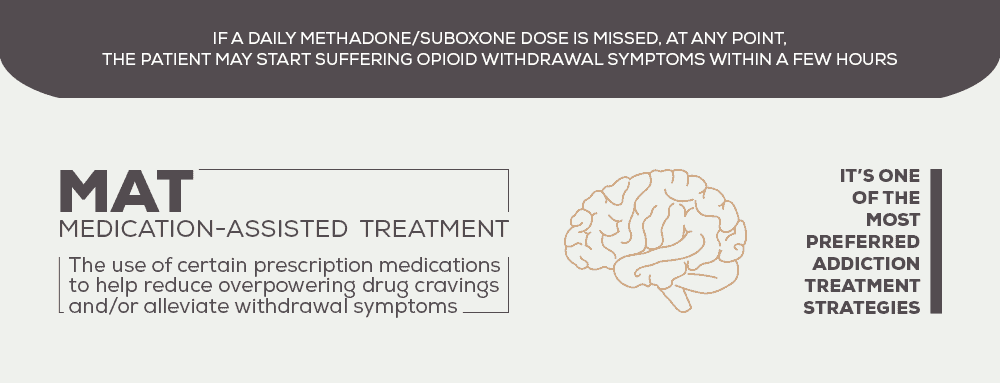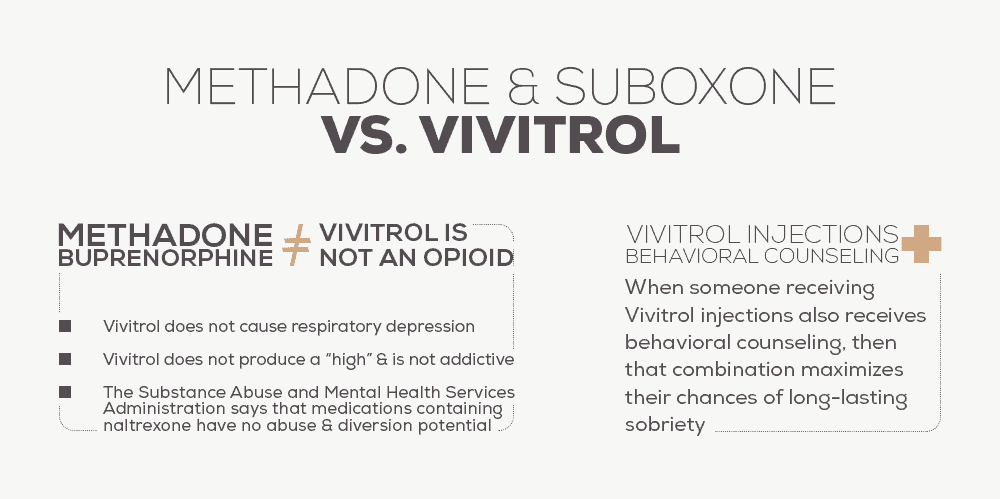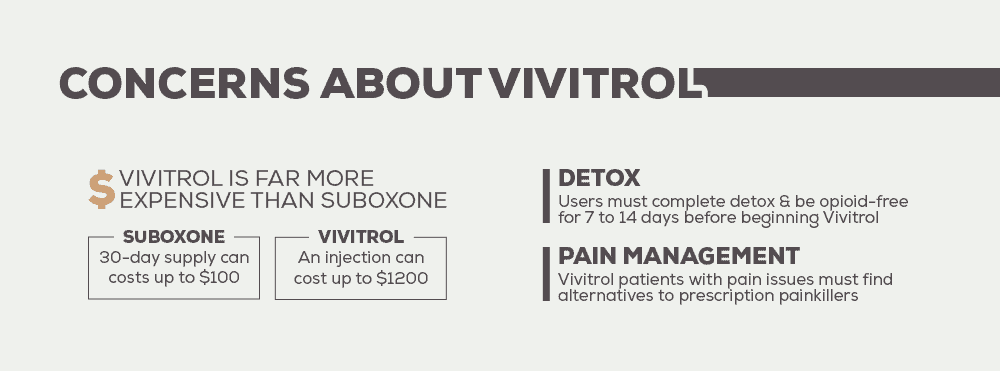During the ongoing opioid epidemic, Vivitrol may just be the addiction recovery drug that America needs. According to a new study published just this month in The Lancet, Vivitrol and Suboxone are equally effective at treating opioid dependence. This was the first American research to directly compare these two very different medications. The implication is clear –both medications should be considered viable treatment options. A smaller Norwegian study published in October reached the same conclusion. Because there is a sore need for evidence-based and effective treatment options for people struggling with Substance Use Disorders (SUDs) involving heroin or prescription painkillers, the results of these studies are a welcome bit of good news.
“Get the help you need today. We offer outpatient assistance, so you can maintain your work, family, and life commitments while getting the help you deserve!”
First Things First – What Is Vivitrol?
Vivitrol is an injectable formulation of naltrexone, an anti-craving medication prescribed for various SUDs involving such substances as:
- Opioids
- Heroin
- Hydrocodone (Lortab, Vicodin, etc.)
- Oxycodone (Percocet, OxyContin, etc.)
- Codeine
- Tramadol (Ultram)
- Methadone
- Buprenorphine (Subutex, Suboxone, Zubsolv, Bunavail, etc.)
- Fentanyl (Duragesic, Actiq)
- Alcohol
- Cocaine
- Methamphetamines
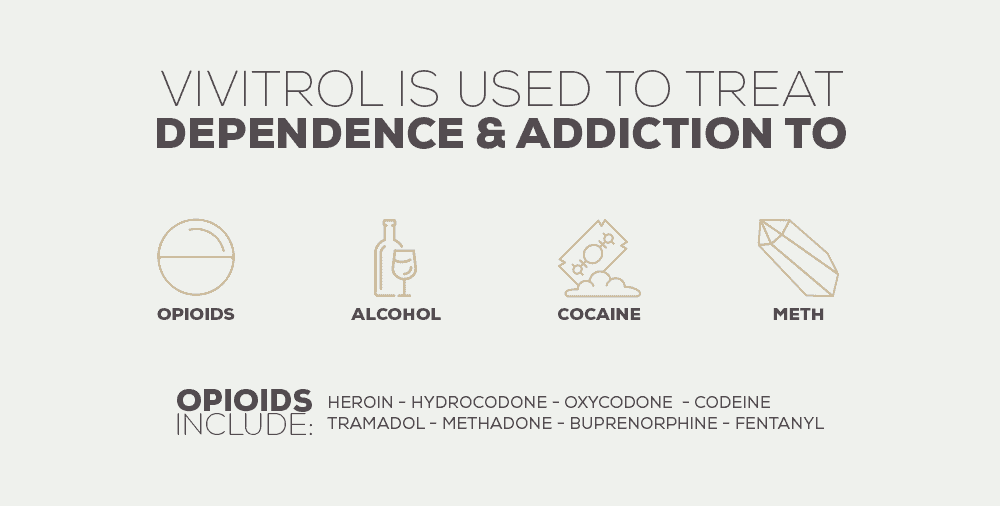
- Kleptomania
- Problematic gambling
- Compulsive hair-pulling
- Non-suicidal self-harm
- Pornography addiction
Right away, the wide variety of therapeutic applications separates Vivitrol from other addiction recovery medications. For example, while the buprenorphine drugs prescribed for opioid addiction can also help with cocaine dependency, methadone has no other recovery-related uses.
How Often is Vivitrol Given?
Vivitrol injections are formulated for extended-release, and only need to be administered once a month. This is in direct contrast to the other top medications used for addiction recovery treatment. Methadone must be taken every day. This typically involves a daily trip to the closest methadone clinic. Because they are take-home prescriptions, buprenorphine drugs are considerably more convenient than methadone, but they still must be taken daily. The once-a-month versus once-a-day distinction can be crucial to successful recovery. If a daily methadone/Suboxone dose is missed – at any point or for any reason – the patient may start suffering opioid withdrawal symptomswithin a matter of hours. The physical pain and mental anguish of opioid withdrawal can be so severe as to trigger a relapse – a return to active drug use.
How Does Vivitrol Work?
Opioids and other abused substances are habit-forming because they affect the areas of the brain that control dopamine levels. Dopamine is part of the brain’s reward system and is associated with motivation, pleasure, memory, and learning. The use – or abuse – of addictive substances triggers a massive release of dopamine. This is what creates the overwhelmingly-pleasurable euphoric “high”. The brain of a substance abuser quickly learns to associate use with pleasure, creating a permanent memory of the experience. Eventually, however, chronic abuse disrupts normal dopamine levels. In other words, the addicted brain stops producing dopamine unless it is under the influence of the abused drug. As a result, the addict is chemically unable to experience positive emotions – or even feel normal – unless the drug is present in their system. And, when that drug is unavailable or discontinued, the addict soon begins to experience irresistible drug cravings and other withdrawal symptoms. Some of these symptoms may last for weeks or even months. The discomfort of withdrawal is what motivates the person to resume drug use. Because certain prescription medications can help reduce overpowering drug cravings and/or alleviate withdrawal symptoms, Medication-Assisted Treatment (MAT) is one of the most-preferred addiction treatment strategies. Vivitrol drug abuse and other medications containing naltrexone are opioid antagonists. This means that they bind to opioid receptors within the brain. Because of this binding, the need/craving for drugs is satisfied, even though no opioid is present. Of special relevance, opioid agonists also create a barrier that block the intoxicating effects of all opioids. In other words, if a person receiving Vivitrol injections tries to abuse any opioid, they will not be able to get high.
“We treat both addiction and co-occurring disorders and accept many health insurance plans. Take a look at our outpatient program today!”
Methadone and Suboxone Work Differently
It is important to note that, unlike methadone or buprenorphine drugs, Vivitrol is NOT an opioid. This has several benefits:
- Vivitrol is not addictive. The Substance Abuse and Mental Health Services Administration says that medications containing naltrexone have “no abuse and diversion potential.”
- Vivitrol does not produce a “high”.
- Vivitrol does not cause respiratory depression.
Methadone, on the other hand, is a powerful opioid that is a full agonist. Even though it is the best-known MAT medication used for opioid addiction recovery, methadone is extremely addictive in its own right. Methadone also presents an elevated risk of fatal overdose. In 2014, nearly 1 out of 4 opioid-related deaths involve methadone. Likewise, Subutex, Suboxone, and other buprenorphine drugs are also synthetic opioids. However, they are classified as opioid partial agonists, presenting a lesser risk of divergence, addiction, and fatal overdose. That does not mean that partial agonists are completely safe. On the contrary, long-term buprenorphine use results in a physical dependency. As is the case with other opioids, the medication is discontinued abruptly, the user can quickly go to opioid withdrawal. Again, it is the discomfort of withdrawal that usually causes relapse. How addictive are drugs like Subutex? Up to one-third of people entering opioid rehab self-report having gotten high on buprenorphine within the previous month. Even “abuse-deterrent” Suboxone is a popular drug of abuse. Opioid addicts often use Suboxone to stay functional in between heroin highs. In other words, they are using the medication to maintain their addiction. One addiction expert in the St. Louis area, says, “…there’s more Suboxone on the street than in pharmacies. Most of the heroin dealers are diversified now. They offer you a choice of Suboxone and heroin. And now with all these generic forms coming out, that is going to explode.”
Vivitrol as a Supportive Therapy
It’s important to remember that, in and of itself, MAT is not a complete program of recovery. Although it addresses drug cravings and may keep the person abstinent from dangerous opioids, it does not address the underlying psychosocial factors that play a role in the development of an addictive disorder. However, when a person receiving Vivitrol injections also receives behavioral counseling, then that combination maximizes the chances of true recovery – long-lasting sobriety and a productive, satisfying life. One clinical study compared the effectiveness of counseling alone versus counseling combined with monthly Vivitrol injections. By any measure, the difference in successful outcomes was striking.
- Just 3% of patients who received behavioral counseling and a placebo self-reported fewer cravings for opioids, compared with 55% of those patients who received counseling and Vivitrol.
- 35% of counseling patients were able to achieve full weeks without opioid use, compared to 90% of counseling/Vivitrol patients.
- On average, counseling patients stayed in opioid treatment for 96 days, while counseling/Vivitrol patients participated in a treatment program for an average of 168 days.
- Counseling patients were 17 times more likely than patients receiving Vivitrol and supportive counseling.
2 out of every 3 rehab clients receiving both counseling and naltrexone medication successfully “graduate” from their rehab program. And when their MAT medication schedule also incorporates clonidine, the completion percentage increases to over 85%.
Vivitrol is The Most-Accessible MAT Drug
Even with all of the other advantages that it has over methadone and buprenorphine, the most favorable aspect of Vivitrol is its universal availability. Any physician who is licensed to dispense medications can prescribe Vivitrol injections. This accessibility is completely different than the situations found with opioid MAT options. Methadone is only dispensed at special clinics. In order to receive their daily dose of methadone, opioid addicts must commit a huge portion of their time and resources. Every single day, they must make a trip to the methadone clinic if they want to avoid getting “sick” – the addict’s term for opioid withdrawal. For some, coming in every day can be a major obstacle, especially if they don’t have a vehicle or a driver’s license. And if there’s no methadone clinic nearby – if they live in a rural area, for example – then merely difficult becomes impossible. Finding a Subutex or Suboxone doctor can be even harder. Although ANY physician can prescribe Vivitrol, that is not the case with buprenorphine medications. These drugs are so tightly regulated that a doctor must complete several hours of specialized training and then meet other licensing requirements in order to offer them to their patients. And even when they meet those requirements, during the first year after certification, there is a strict limit on the number of opioid-dependent patients they can treat using buprenorphine – 30 patients at a time. These very stringent extra requirements have created a shortage of buprenorphine doctors. Currently, less than 3% of American physicians prescribe buprenorphine. How bad is the shortage? About half of all US states and territories have less than 100 properly-certified physicians. This means that in some cases, a person might spend months on a waiting list. And, again, this problem is even greater in rural areas.
What Are the Concerns about Vivitrol?
Despite all the advantages that Vivitrol offers over other MAT drugs, there are some concerns that should be considered before initiating an injection schedule:
- Price – Vivitrol is far more expensive than Suboxone. While a 30-day supply of Suboxone cost approximately $100, a single Vivitrol injection can cost up to $1200.
The solution? Most of this expense is usually defrayed by private insurance.
- Delayed treatment – Because Vivitrol greatly reduces the person’s tolerance for opioids, is necessary to undergo a complete detoxification procedure and be totally opioid-free for 7 to 14 days before Vivitrol treatment can begin.
The solution? This is not particularly unusual. Detox is often a necessity for many people wanting to recover from an addictive disorder. The discomfort of withdrawal can be eased greatly in a medically-supervised facility.
- Pain management – Because of the lower opioid tolerance, Vivitrol patients with pain issues must find alternatives to prescription painkillers.
The solution? Again, this is not unusual. Last year, new guidelines were put out concerning when and how opioids are prescribed. Doctors are instructed to attempt other pain management methods – weight loss, exercise, massage, etc. – before turning to opioids as a “last resort”.
- Risk of opioid overdose – Even Vivitrol blocks the intoxicating effects associated with opioid abuse, it does not prevent overdose complications when someone takes high doses of opioids.
The solution? Vivitrol injections should be part of a comprehensive program of recovery. Anyone still finding it difficult to remain abstinent should address these difficulties with their addiction counselor.
- Potential liver damage – Vivitrol is not recommended for anyone suffering from liver disease or damage. Unfortunately, liver problems are common among chronic substance abusers.
The solution? Before starting Vivitrol or any new medication, ALWAYS discuss your medical history with your prescribing physician. ” column_min_width=”[object Object]” column_spacing=”[object Object]” rule_style=”[object Object]” rule_size=”[object Object]” rule_color=”[object Object]” hide_on_mobile=”[object Object]” class=”[object Object]” id=”[object Object]”][object Object]
Why is This Evidence Supporting Vivitrol So Important?
For the last few years, every subsequent year has set a tragic new record for the number of lives lost due to fatal drug overdoses. Between 2014 and 2017, the number of drug deaths in this country has increased by 52%. In the last two years, drugs have killed more Americans than the Korean and Vietnam Wars COMBINED. The biggest factor in the increasing number of drug deaths is the ongoing – and worsening – opioid epidemic in America. 67% of all fatal overdoses are opioid-related. To be even more specific, the opioid epidemic is being fueled by an explosion of overdose deaths involving either fentanyl or heroin. In 2016 alone, these two dangerous opioids claimed the lives of almost 37,000 people in this country. This clearly demonstrates that there is a critical need for more effective and evidence-based strategies that can be used to turn the tide of opioid abuse, addiction, and overdose. There IS good news – these numerous studies ARE the evidentiary base that proves how effective is Vivitrol is at curbing opioid cravings and supporting a fully-abstinent lifestyle of recovery.
What Did you Think About This Blog?
Give it a Rating!


